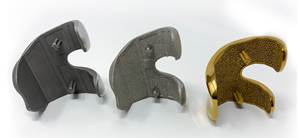A Look at Additive Manufacturing in Minnesota
Increasing interest in 3D printing among machine shops was particularly conspicuous during a recent visit to multiple shops in Minneapolis, Minnesota.
Last December, I spent four days visiting seven CNC machine shops in and around Minneapolis, Minnesota. Something I found interesting is six of them are using 3D-printing equipment in some way.
One of those six shops is Monticello’s Ultra Machining Company (UMC), which primarily serves the aerospace and medical markets. UMC purchased its 3D printer in 2014, a Stratasys Fortus, that prints parts in acrylonitrile butadiene styrene (ABS) polymer.
UMC uses its printer in various ways. During the quoting and design for manufacturability stages, it commonly 3D prints prototypes for the new job. This is, perhaps, the most common use of plastic 3D printers among machine shops. Engineering Manager Corey Fouquette says this gives UMC a better idea of how to best fixture the part on a machine, helps identify areas where cutting tool or spindle clearance might be an issue, helps determine the best way for a tool to approach a certain feature to be machined, and so on. “Some of this you can glean by examining the part’s 3D CAD model, but we often find it more beneficial to have something physical to hold and manipulate by hand,” he notes. For large aerospace parts, UMC might 3D print them at a smaller scale.
The shop also 3D prints fixtures that secure parts to be measured on its coordinate measuring machine. One example I saw was a two-piece fixture featuring a base and hinged door. Once the part is installed in the fixture base, the door is closed around it and magnets keep it shut. Because it is made from polymer and not metal, it will not mar a part’s finish. This is important because those parts are machined for a medical application in which appearance is just as important as functionality.
Plus, turnaround time to 3D print the fixture is faster than making one from metal. “We can 3D print both components of this fixture at the same time in 24 hours,” Mr. Fouquette says. “It would take upwards of a week to make this out of metal when you consider the time it would take to obtain material, machine what would be five components, then assemble them.” The only assembly required for the polymer fixture is adding a pin to connect the door to the base. The print job is paused at a certain point to add the magnets, then printing continues, securing the magnets in the polymer.
Mr. Fouquette says UMC’s printer runs nearly 24/7. That certainly was not the case early on. “Our employees pretty much ignored it at first,” he says. “However, we launched an engineering internship program about the time we purchased the printer. Although those college juniors and seniors were ‘green’ when it came to conventional machining and manufacturing approaches, they really took to the 3D printer. They were designing and printing parts within a matter of days.”
In fact, the students solved a problem the shop was having protecting certain areas of a part during grit blasting. Their idea was to 3D print molds to create rubber masks to protect the areas of the part that did not call for an abrasive surface finish.
“Our seasoned employees saw what those ‘inexperienced’ young people were doing with our 3D printer, and that spurred them to learn how to use it and how to benefit from it,” Mr. Fouquette says. “That’s the key. You have to ingrain 3D printing into your shop’s culture.”
Related Content
4 Ways 3D Printing Is Changing Medical Implants
Additive manufacturing provides new ways of making medical implants, but its impact is greater than this. How 3D printing is changing medical manufacturing and improving patient outcomes.
Read MoreThe Benefits of Vertically Integrating Metal 3D Printing and Machining
Having 3D printing and machining within one organization enables Addman’s engineers to collaborate and consolidate so it can quickly make successful metal 3D printed parts.
Read MoreAn Additive Manufacturing Machine Shop
Finish machining additively manufactured implants requires different pacing and workflow than cutting parts from stock — different enough for an experienced manufacturer to warrant a dedicated machine shop.
Read More5 Tips for Getting the Most From the Historic Return of North America’s Biggest Manufacturing Event
Plan. Explore. Think of the future. And oh yeah, the shoes. Here is how to get the most from the major manufacturing event that none of us have experienced in four years, and that many will be experiencing for the first time.
Read MoreRead Next
The Cut Scene: The Finer Details of Large-Format Machining
Small details and features can have an outsized impact on large parts, such as Barbco’s collapsible utility drill head.
Read MoreObscure CNC Features That Can Help (or Hurt) You
You cannot begin to take advantage of an available feature if you do not know it exists. Conversely, you will not know how to avoid CNC features that may be detrimental to your process.
Read More3 Mistakes That Cause CNC Programs to Fail
Despite enhancements to manufacturing technology, there are still issues today that can cause programs to fail. These failures can cause lost time, scrapped parts, damaged machines and even injured operators.
Read More
.jpg;width=70;height=70;mode=crop)












.png;maxWidth=300;quality=90)












